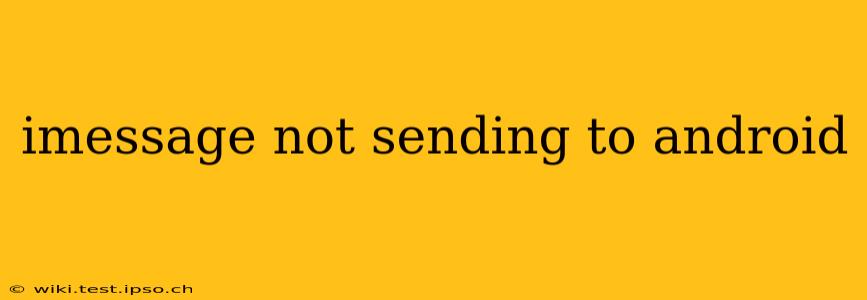iMessage, Apple's popular messaging service, offers a seamless experience for Apple users. However, if you're trying to send an iMessage to an Android contact and it's not going through, you're not alone. This issue is surprisingly common, and thankfully, often solvable. This guide dives deep into the reasons why your iMessages might not be reaching Android devices and provides practical solutions to get your messages delivered.
Why Aren't My iMessages Sending to Android?
The core reason iMessages don't work with Android phones is simple: iMessage is designed for Apple devices. It uses Apple's servers and infrastructure, which Android devices don't integrate with. Therefore, unless a message is explicitly sent as an SMS/MMS, it will remain trapped within Apple's ecosystem.
Let's explore the common scenarios and troubleshooting steps:
1. The Recipient's Phone Number Isn't Registered with iMessage
This is the most frequent culprit. If your contact's phone number isn't registered with iMessage (meaning they don't have an iPhone or other Apple device using iMessage), the message won't be delivered as an iMessage. Instead, it should automatically fall back to SMS/MMS, provided your phone is properly configured. If this fallback isn't working, see troubleshooting steps below.
2. iMessage Settings and Configuration Issues on Your iPhone
-
Check your iMessage settings: Go to your iPhone's Settings > Messages. Ensure that "iMessage" is toggled ON. If it's off, iMessages won't send at all.
-
Verify SMS/MMS Messaging: Within the same Settings > Messages menu, make sure that "Send as SMS" is enabled. This crucial setting ensures your message will be automatically sent as a standard text message if iMessage fails to connect. This is the fallback mechanism when sending to a non-iMessage user.
-
Network Connectivity: Confirm you have a strong cellular or Wi-Fi connection. Without a stable internet connection, iMessages might fail to send, even if "Send as SMS" is enabled. Try restarting your iPhone and your router/modem.
3. Carrier Issues Affecting SMS/MMS
If iMessage fails and SMS/MMS doesn't work either, it may indicate a problem with your mobile carrier. Contact your service provider to check for network outages or issues affecting texting services. They might need to reset something on their end, or there might be a temporary outage in your area.
4. Blocking or Filtering Issues
Though less common, check if the recipient has accidentally blocked your number, or if there are any filters or restrictions in place on their phone (or their carrier's network) that might be preventing the messages from coming through.
5. iOS Bugs or Glitches
Rarely, a bug in the iOS operating system could interfere with iMessage functionality. If you've tried everything else and still can't send messages, consider checking for iOS updates. A recent update often fixes minor bugs or glitches that can disrupt messaging.
What to Do If iMessage Still Isn't Sending to Android
If you've followed the above steps and your iMessages are still not reaching Android devices, try these more advanced troubleshooting techniques:
-
Restart your iPhone: A simple reboot can resolve many temporary software issues.
-
Check for iOS updates: Outdated software can sometimes cause compatibility problems.
-
Sign out and back into iMessage: Go to Settings > Messages > Send & Receive and sign out of iMessage. Then, sign back in.
-
Contact Apple Support: If the problem persists after trying all other troubleshooting steps, contact Apple Support for assistance. They may be able to diagnose deeper technical issues.
By carefully reviewing your settings, network connectivity, and carrier services, you should be able to resolve most iMessage delivery problems to Android phones. Remember, the key is ensuring your iPhone is properly configured to send SMS/MMS messages as a backup when direct iMessage delivery fails.
